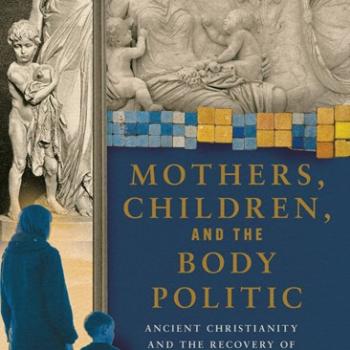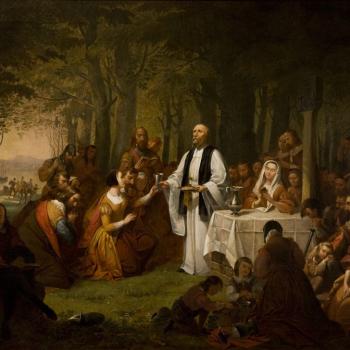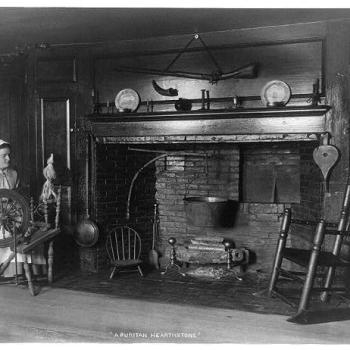A New York Times report earlier this year on trends of stylish Brooklyn moms put me in mind of Puritan sumptuary laws. The article notes, “in Brooklyn recently, a decidedly more bohemian expression of middle-aged fashion has emerged.” The specs: you buy moderately expensive chunky shoes and a very expensive purse, which you rusticate by attaching a patterned strap.
“This ensemble is made up of two accessories: Part 1 is the No. 6 clog, which has become ubiquitous in upscale Brooklyn neighborhoods and on celebrities like Keri Russell, Julianne Moore and Claire Danes.
Part 2 is the Salt strap, a thick, detachable handbag strap woven from bright colors, made to hook onto luxury bags, as Salt’s Instagram account promotes vividly, like the $2,500 Gucci, the $3,300 Hermès, a $2,600 Celine or a $1,700 Chloé.”
Americans may cringe at reserving some garments only for a particular class or legislating what people can wear. But in other periods people living here were quite willing to do so, from sumptuary laws in early New England to Revolution-era preference for homespun garments to show solidarity with the patriot cause.
Our clothes can carry moral freight. They may be weighted in a range of ways. Clothes may communicate slogans, sexual suggestion, or religious identity. Sporting animal furs or skins can highlight humans’ harsh dealings with other creatures. Fast fashion may feature cruel labor practices and environmental damage.
For seventeenth-century Massachusetts Bay Colonists, what was worrisome about some clothes was the way they broadcast wealth. For solid Puritan reasons the Massachusetts colonial government strove to quash harmful effects of newfound wealth on people unaccustomed to it through sumptuary laws, rules to check extravagance in dress or property. In 1634, the Massachusetts General Court passed laws condemning “greate superfluous, and unnecessary expenses occasioned by reason of some newe and immodest fashions,” people of insufficiently high station wearing “silver, golde, and silke laces, girdles [and] hatbands.” Additional sumptuary laws were passed in 1651, 1662, and 1714. In 1652 Jonas Fairbanks, skilled worker at the Hammersmith Ironworks in Lynn, Massachusetts, was fined for wearing showy boots. Massachusetts ordered persons to use goods soberly, as Stephen Innes narrates in Creating the Commonwealth, so “the Court banned the wearing of gold and silver lace, great boots, knee points, silks, and tiffany hoods” by people with smaller property holdings.
These garments were not wrong in themselves, but wrong for by people whose wealth would not customarily allow such display. Those boots and buttons and lace highlighted behaviors that worried Puritans: inordinate love of worldly things, envy, social mobility, rising above one’s station. The problem was not the clothes but the mismatch between the “meane” status of the wearers and the luxury of the items. The General Court worried about the corruption of the rising generation—this being a recurrent worry—if this trend continued.
The point of sumptuary laws was to help distinguish people by their class, through the length of a coat or the style of a hat. Puritans wanted to stem greed but also social mobility. Aside from accusing witches and persecuting Quakers, opposing social mobility is one of the most offensive things about Massachusetts’ Bay colonists, at least among the students I have taught, young people raised to prize meritocracy. Most Americans now do not think, as John Winthrop thought, that God makes some people high and others low on purpose. Indeed, to some, social mobility is practically the cornerstone of the American dream.
But I suspect that if present-day judges of Puritanical judgement focused on the purpose of these laws rather than being distracted by opposition to individuality and style, they might have to admit more in common with seventeenth-century folk than they let on. The General Court’s laws on lace and silks meant to keep social levels easily recognizable, so people of the same class could find each other. Or, as the Times article puts it, “wearing the same clothing sends a signal: On the one hand, it links you to people you want to resemble, and on the other it separates you from people you don’t want to resemble.”
The Brooklyn mom uniform functions quite smartly on those terms. The article interviewed several women sporting strap- and clog costumes. They described their enjoyment of the combo not only in aesthetic terms but class terms.
“Ms. Ginsburg was glad to see the strap taking off around Brooklyn and didn’t think that an army of look-alike moms was impeding her look.
“It’s like we’re matching,” she said, noting that the strap reminded her of the woven friendship bracelets she used to make in camp. “It’s a unique way of styling yourself. When I see someone in a strap or a clog I don’t have, I think, ‘That looks good. I want that.’”
Of course, it’s not actually a unique way of styling yourself when the thing you pick looks mostly the same as what others around wear. Operative in admiration of other women’s straps and clogs is not only envy—“I want that”—but tribe-marking. Indeed, the article situates strap-clog style not only in culture but in nature: “Our evolutionary prehistory shows that we needed many people to help us raise our offspring, so we surrounded ourselves with those who had similar values or who looked like us.” Women compare the straps to friendship bracelets, establishing a “sisterly bond.” It can be tricky, in a land where fortunes can rise and fall, to know who might have values similar to yours. Thus, signaling it by appearance could be all the more important.
One woman interviewed in the article admitted, “You can see how important it is for mothers to do this particularly when you consider how strange and isolating and depleting we have made motherhood in our culture,” she said, explaining that it was through these fashion choices, this “very canny social strategizing, we survived as a species through affiliating with others and by making others feel like kin.”
Those words accentuate a second sore spot in this uncannily rich treatment of clothing: the way in which American women, particularly mothers, have been encouraged to build identities around consumption. A woman could be “Mrs. Consumer,” as early twentieth-century domestic expert Christine Frederick imagined. Women were not mostly to be builders or lovers or visionaries or exemplars but buyers of stuff. To contextualize the clog-strap combo, the article contrasted it with other socially approved ensembles for mothers:
“In the 1950s, women across the country wore practical, button-down housedresses with tight waists and deep pockets. In the ’80s, shoulder pads were a symbol of power in the workplace, but also up and down supermarket aisles. In the aughts, moms (and their daughters) wore a whole lot of Juicy Couture velour sweatsuits.
For years, black Lululemon yoga pants and Uggs were the axis of the mom uniform, until the media cruelly shamed women out of them. Then last year, a pair of deliberately beaten-up-looking $500 Golden Goose sneakers and what is known as simply the “Amazon jacket,” a $130 parka, was seen on moms in Chappaqua and Short Hills alike.”
Cruelty hits more than yoga pants in that summary. Stay-at-home motherhood configured as a status symbol is marked extra time it affords for shopping. This mom-uniform phenomenon demonstrates why no sumptuary laws are even necessary: all by themselves, market forces and personal taste make it easy to recognize who’s worth what. The quirkiness of the strap helps deter social climbers from trying to ape their way into the group. Sure, anybody with an extra $2,500 can drop it on a Gucci purse but they might not know about the strap.
This mom uniform might be easy to revile. There’s the middle-school style pettiness implicated in sorting the moms you want as friends by their clogs and purse. There’s the hypocrisy of pitching oneself as down-to-earth by bedecking a luxury bag with a moderately expensive swath of weaving or by footwear that, as the article notes, originated with the working class, coming from “Dutch dairy farmers and later became a common work shoe in Europe during the Industrial Revolution.” Then there’s the conscience-soothing provided by the strap’s contribution to Colombian craftswomen.
“Yet because of its straight-out-of-Laurel-Canyon-circa-1969 look, combined with a charitable element (Salt has a partnership with artisans from the La Guajira region of Colombia, according to its website, and donates a portion of its proceeds to the Wayúu Tayá Foundation, a Colombian nonprofit), the strap, in a way, “counters or at least reduces the extravagance of the bag,” said Carolyn Mair, a psychologist and founder of a consultancy firm, Psychology.fashion.
“I think it’s less acceptable now, at least in some circles, to be totally oblivious to the problems in the world,” Ms. Mair said. “So perhaps by wearing the strap, these women want to be seen as acknowledging issues elsewhere by supporting a social cause.”
That statement contains too many convolutions to be self-parody.
But it is also pitiable, that admission of the strap- and clog-wearer who lamented “how strange and isolating and depleting we have made motherhood in our culture.” She is right about that piece at least. The demands laid upon mothers not only by the actual needs of small bodies but the institutions of intensive parenting have rigged up standards that make childrearing strange and isolating. As historian Rebecca Jo Plant demonstrates, American mothers have been stung by shifting currents of expectation. Our culture’s image of the Mom—in yoga pants or sweatsuits or clogs—mocks women for strenuous efforts even as it insists they keep making them.













